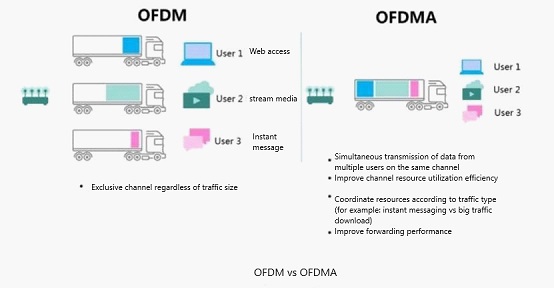OFDMA stands for Orthogonal Frequency Division Multiple Access. It can be seen as a new technology or an improvement on an existing technology. OFDMA is one of the technologies that make up the high functionality of WiFi 6. It improves the performance of wireless networks by creating and modulating sub-carriers within the network frequency band. With this approach, higher WiFi standards such as WiFi 6 and later WiFi 7 will facilitate simultaneous transmissions between multiple clients and users.
OFDMA Able to Create an Access Point To Serve Multiple Users Simultaneously

Orthogonal Frequency Division Multiple Access is a feature of the WiFi 6 standard that enables an access point to serve multiple clients simultaneously. OFDMA is a multi-user version of the existing, well-known Orthogonal Frequency Division Multiplexing (OFDM) digital modulation scheme. OFDMA enables multiple access that is not possible with OFDM by creating and assigning subsets of subcarriers to different end clients.

Orthogonal Frequency Division Multiple Access is an improved version of OFDM that improves upon the previous Frequency Division Multiplexing (FDM) technique. OFDMA technology is synchronized with the switch of Internet operators and routers to WiFi 6 technology. It also aligns with the rollout and use of 5G networks and 4G networks for telephony services on 3G and 3G LTE. OFMDA replaces the old analogue modulation technique with a carrier signal wave in digital format.
OFDMA technology is guided by a series of rules and algorithms for transferring data between multiple terminals. A terminal can be any device, such as a phone, laptop, game console, iPad, etc. The transfer is done over a wireless network.

OFDMA is considered well-suited for broadband wireless networks because its advantages include scalability and multi-antenna (MIMO) friendliness, as well as the ability to exploit channel frequency selectivity. Previous technologies such as FDM and OFDMA have multiple vulnerabilities and extremely low resource utilization.
FDM requires spacing between signals to avoid overlapping, resulting in a wide range of frequencies and reduced availability. With OFDM, these frequencies are strategically located and access points can more easily distinguish between different data transmissions. Signals are allowed to overlap so that data can still be sent efficiently. Therefore, a lower range of band frequencies is used in OFDM. OFDMA outperforms all of them because it further creates subcarriers within each frequency.

